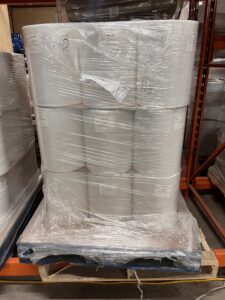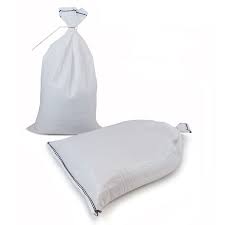Burlap has gained popularity among gardeners for seeding, grow beds, animal protection, and more. Because of burlap being naturally biodegradable, it is a commonly used fabric. But beware as some burlap manufacturers use trace amounts of oil in the manufacturing process to help knit the jute fibers together.
Burlap is made from the natural fibers of the Jute plant, and contributes to a circular economy, meaning that at the end of its life-cycle, it can be composted, and help reduce waste and demand for commercial materials, making it a very sustainable, eco-friendly option. Pure natural burlap can completely decompose in 2-3 years if subjected to the proper environment, and can thus act as fertilizer for your plants. It’s important to note that only natural burlap is biodegradable, as there are synthetic alternatives where it is woven like burlap, however it is made of plastic fibers. These such bags are not biodegradable.
Lets dive in!
Burlap vs Jute
Burlap and jute are often interchangeable. One is referring to the plant, and the other to the finished fabric. Burlap bags are made from jute plants commonly found in Bangladesh. Hessian and gunny sack are also interchangeable with burlap and jute, oftentimes people are referring to the same thing when talking about any one of them.
Burlap in Gardening
Burlap is very versatile when it comes to gardening applications. From moisture and animal control, to protecting plants themselves, or acting as grow beds. Because it will naturally degrade and absorb into the ground, leaving little trace.
Tree Wrapping and Animal Control
Here at St. Boniface Bag Company, our 40” wide rolls of Burlap are commonly used in fall for wrapping tree’s, protecting them from the winter frost as well as from Deer. Evergreen trees are a target for Deer in the fall and winter seasons, by wrapping them in burlap you will protect the branches from being eaten by Deer.
Tree Transplanting
Young tree’s when transplanted commonly have their roots wrapped in burlap. This helps keep the roots and soil together when planting in a new hole, by keeping the original rich soil that the tree was grown in, it will help keep the root system active in their new home. The holes in burlap fabric are large enough that the root system can grow beyond without needing to remove the burlap allowing for direct planting. Because the burlap is biodegradable, you can plant the tree in the ground, leaving the burlap, covering with soil, and leaving as is!
Advantages in Grow Beds and Gardening
Weed Control: Lay burlap over the soil in your grow beds to suppress weeds. It acts as a barrier to prevent weed seeds from germinating while still allowing water and air to reach the soil. The lasagne method involves covering your garden with cardboard and leaves or mulch and letting it compost over the winter season. Laying burlap instead won’t compost in one winter season but will help with weed control from year to year. Cardboard can be difficult to manage as most people don’t want cardboard with printing, ink, or tape. Finding large enough cardboard can also be difficult so most garden beds end up with pocket of weeds growing through where the cardboard can’t fully cover the ground. Burlap can be quickly and easily laid over the garden bed covering 100% of the soil.
Soil Erosion Prevention: If your grow beds are on a slope or prone to erosion, burlap can help stabilize the soil. Spread burlap over the soil and secure it with stakes or soil to prevent the top layer from washing away.
Mulching: Burlap can be used as a mulch to help retain soil moisture and regulate temperature. Lay it on the soil surface around your plants, and then add a layer of organic mulch like straw or wood chips on top. This setup helps to keep the soil moist and reduce temperature fluctuations.
Root Protection: If you’re growing plants in containers or raised beds, you can use burlap to line the bottom and sides of the containers to help prevent soil loss and root damage. It also helps with drainage by allowing excess water to escape while keeping the soil in place.
Composting: Burlap can be used in composting setups to help contain and aerate compost materials. It’s particularly useful in compost bins or piles to hold together organic matter and improve air circulation. Burlap can improve soil structure, water retention, and nutrient content. This makes it beneficial for garden soils as it enhances soil health over time.
Temporary Covers: During extreme weather conditions, you can use burlap to cover plants in grow beds to protect them from frost or excessive sun. Simply drape the burlap over the plants and secure it to prevent it from blowing away.
Seedling Protection: When starting seedlings in grow beds, burlap can provide a gentle, breathable cover to shield young plants from harsh elements and pests while allowing them to acclimate to outdoor conditions.
Burlap can be cut to size and can act as a seed mat to help improve germination, as it retains moisture and prevents seeds from washing away, prevents birds from eating the seeds, and helps maintain even spacing.
Steps to use burlap for successful germination
1. Sow your seeds according to packaging
2. Cut a piece of burlap to your desired size, and lay overtop of seeds
3. Water when the soil gets dry
4. Check daily for germination
5. Remove burlap once seeds have germinated
Burlap in Farming
The most common application of burlap in farming is with Bee farms. Bee farmers will take burlap to burn in their smokers, causing the bee’s to become more docile and less likely to sting. Allowing the farmers to harvest their protected honey and to inspect the bee hives.
There are many alternatives to burlap smoking for bee hives, such as electric smokers and essential oils. Burlap can be a very cheap and effective source as it burns slowly, consistently, and is widely available in the market.
Root Ball Wrapping and Plant Transport
Techniques for wrapping root balls in burlap
A method commonly used in gardening is called the B&B method, which is shorthand for the “Balled and Burlapped” method. This method is exactly what it sounds like. You wrap a root ball in burlap, and then you are able to transplant said plant in a new location. You should only be transplanting plants while they are dormant, for example, you would only want to transplant trees during the time between the last leaf falling, and the buds sprouting in spring. The size of the root ball that you should make depends on the plant that you are transplanting. For evergreen shrubs and trees, 1 foot of root ball for every 2 feet of height is recommended. It is important to err on the side of generosity however, as once you sever a root, you cannot go back. For deciduous shrubs and trees, we calculate how big the root ball should be according to its diameter. Usually it’s about 1 foot for every inch of diameter, and it is recommended to measure 6 inches off the ground.
Advantages of burlap for transporting plants
Not only does burlap protect plants against the elements, it is also biodegradable, so in the example of a root ball, it can be planted straight in the hole, and it will naturally decompose, acting as fertilizer for your newly relocated plant.
Potential Drawbacks and Solutions
Decomposition Concerns
Generally speaking Burlap can decompose in roughly 12 months under ideal circumstances. Making it not an ideal brown item to add to your compost pile as it can take too long to break down and be used.
Burlap has a slight acidic tone as it decomposes into the ground it could slightly impact the pH levels of your soil. Soil is fairly durable in it’s pH levels and can maintain it’s balance quite well despite the potential imbalance that burlap can provide.
Pest Issues
- Slugs and Snails
- Burlap can attract slugs and snails underneath as it retains quite a bit of moisture in the ground causing an environment that most slugs and snails will be prone to. Regularly lift or rotate the burlap to avoid pests from holding up underneath.
- Rodents
- Burlap stored indoors or in a location that provides shelter will be a natural nesting place for rats or mice. Burlap can retain food or plant material attracting mice as well. Keep burlap clean and stored properly by housing in tightly knotted bags.
- Fungi and Mold
- Burlap that is damp for long periods of time can attract mold. If storing to use for later seasons, be mindful to store properly in a place that won’t build up a large amount of moisture.
Potential Chemicals Found in Burlap
Many burlap mills use very small amounts of mineral oil to soften the fiber for weaving. This is standard and there is a possibility of some smell. However some mills have started using vegetable oil that is more natural and reduces most of the drawbacks people have with burlap with a slightly higher cost.
Mineral oil can drastically offset the biodegradable uses of burlap and any potential uses in gardening or farming and it is ill-advised to have the mineral oil leech into your garden beds.
Conclusion
Burlap is a popular choice in gardening and farming due to its natural, biodegradable properties, making it a sustainable option for various applications like tree wrapping, weed control, and root protection. Made from jute, burlap contributes to a circular economy and can be composted at the end of its lifecycle. However, gardeners should be cautious of potential drawbacks, such as attracting pests, mold, and the use of mineral oils in some burlap products that can affect its biodegradability. Proper storage and choosing natural, untreated burlap can help mitigate these concerns, ensuring burlap remains an eco-friendly and effective tool in gardening and farming.




